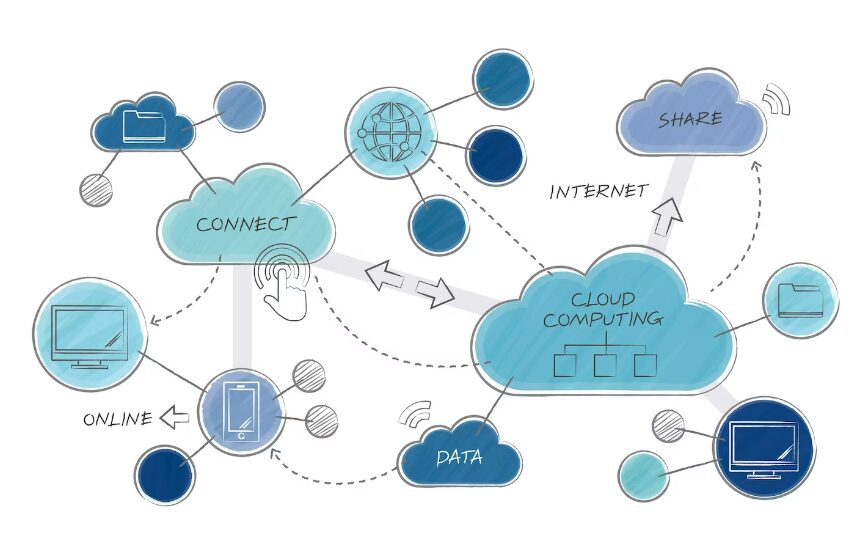Almost every organization (98% to be exact) that uses cloud computing is now using multi-cloud setups, as found in a recent Oracle study. As cloud technology rapidly changes, organizations must also update their security measures to protect their cloud setups. Strong multi-cloud security is essential to guard against cyber threats and breaches.

Understanding Multi-Cloud Security
Nowadays, many organizations opt to use cloud services from multiple providers. This approach offers them increased flexibility, reduces risks linked to relying on a single cloud service, and enhances the performance of their information technology (IT) systems.
Think of this strategy as similar to how investors diversify their portfolios by investing in a mix of financial assets like stocks and bonds. This diversification acts as a safety net against unexpected problems.
For instance, if one cloud service provider experiences issues, such as downtime or service disruptions, the organization can quickly switch its digital operations to another provider within its multi-cloud setup. This flexibility ensures that the organization’s digital activities stay strong and adaptable, much like a diversified investment portfolio that remains more stable through market ups and downs.
However, to make the multi-cloud strategy effective, robust security measures are essential. Multi-cloud security functions as the protective shield for an organization’s digital assets. It safeguards the security, integrity, and accessibility of various digital resources, including employee details, business data, and legal documents.
Securing Cloud Environments: A Must for Modern Organizations
Today’s organizations rely heavily on the cloud for everything from data storage to running essential business operations. It’s crucial to protect these cloud environments for several key reasons:
- Data Privacy: It’s vital for organizations to block unauthorized access to sensitive details like strategic plans and customer information. Protecting this data also helps prevent fraud and ensures compliance with data protection laws.
- Business Continuity: Having multi-cloud security is like having a safety net that ensures businesses keep running smoothly, even during unexpected events like power failures or issues with servers.
- Mitigation of Cyber Threats: Cyber threats pose serious risks to data security and operational stability. Multi-cloud security acts as a powerful shield, protecting organizations from cyber attacks and keeping their data safe from threats.
Understanding and implementing robust cloud security can significantly benefit any organization, helping to safeguard its operations and maintain its reputation.

Exploring Top Cloud Infrastructure Options
The world of cloud computing is filled with various options that help organizations tailor solutions to their specific needs. Here’s a look at some of the top cloud infrastructure providers frequently chosen by businesses.
Amazon Web Services
Known for its extensive range of services, Amazon Web Services (AWS) offers everything from storage solutions to machine learning tools. Its adaptability makes it a favorite among businesses across different sectors, providing scalable solutions no matter the industry size.
IBM Cloud
IBM Cloud is crafted for the intricate needs of large enterprises, focusing on reliability and continuous innovation. It’s the go-to for companies looking for a dependable and advanced technological infrastructure.
Google Cloud Platform
Google Cloud Platform (GCP) is a haven for developers eager to explore data analytics, machine learning, and other groundbreaking technologies. It provides a sturdy and scalable infrastructure ideal for businesses that prioritize the forefront of technology and data services.
Microsoft Azure
Microsoft Azure delivers a comprehensive array of integrated services covering computing, storage, networking, analytics, and artificial intelligence (AI). Companies already familiar with Microsoft products often choose Azure for its seamless integration with existing systems.
These platforms are essential tools for businesses aiming to leverage the power of cloud computing to enhance their operations and drive innovation.
Hybrid Multi-Cloud Infrastructures
Rather than sticking with a standard multi-cloud arrangement, companies often opt for what’s known as a hybrid cloud strategy. This method combines both public and private clouds from various service providers. The key advantage? It offers a versatile way to merge traditional on-premise computing systems with external cloud services.
This hybrid approach serves as an effective bridge linking old-school systems with cutting-edge cloud technology. This combination allows businesses to maintain their existing infrastructure while leveraging the expansive capabilities and innovations of cloud platforms.
Moreover, hybrid setups are particularly beneficial for organizations that have specific regulations regarding data storage or those seeking heightened control and security for particular operations. By adopting a hybrid model, these organizations can manage their most sensitive data onsite while still harnessing the power and efficiency of cloud services for other functions.

Exploring Multi-Cloud Security Fundamentals
Multi-cloud security is essential for protecting data and applications spread across several cloud platforms. It relies on two main pillars: the consistent application of security measures across various cloud services and centralized oversight and control.
Consistent Security Across Multiple Cloud Platforms
To guard against cyber threats effectively, organizations must apply uniform security protocols across their multi-cloud setups. This uniformity ensures that no matter which cloud service is holding the data, it’s protected under the same stringent security guidelines.
This includes standardizing authentication processes, encryption standards, and access controls. Having these consistent security measures makes it easier for security teams to implement and oversee protections, simplifying the management of different security architectures.
Centralized Management and Monitoring
The second cornerstone of multi-cloud security is centralized management and monitoring. This approach uses central tools and platforms to manage security across all cloud environments. With a centralized dashboard, security teams can watch over the systems, spot unusual activities, and act swiftly to tackle potential security issues.
Central management makes it simpler to enforce security rules uniformly and address any issues quickly. This proactive method enhances both oversight and control, which are crucial for protecting the security of the multi-cloud environment and ensuring the safety of digital assets.

Essential Elements of Multi-Cloud Security for Beginners
Creating a secure digital environment requires several critical components that, though often invisible, are vital for maintaining robust security frameworks. Additionally, it’s key to distinguish between information security and cybersecurity, especially when dealing with multi-cloud environments.
Information security is broader and covers the protection of all types of information, whereas cybersecurity is specifically about protecting digital data from online threats. Understanding this distinction is crucial when building an effective multi-cloud security strategy.
Managing Identities and Access
Identity and Access Management (IAM) is about controlling who can access different resources in a multi-cloud environment. Think of IAM as a sophisticated key card system for your digital files and programs: it ensures that each person has access only to what they need and nothing more. This is crucial for preventing unauthorized access and protecting sensitive information.
Securing Data Through Encryption
Data encryption is like putting your data in a secure, unreadable format, whether it’s stored or being sent across different systems in the multi-cloud environment. This secure “envelope” means that even if someone intercepts the data, they can’t understand it, adding a critical layer of defense against unauthorized access and breaches.
Network Security: Guarding Data Flow
Network security is about protecting the digital pathways that connect different cloud platforms. It ensures safe data transfer across these networks and acts as a vigilant guard against threats. By monitoring and blocking potential dangers, network security helps prevent unauthorized access and data breaches, preserving the integrity of your data as it moves.
Compliance and Governance: Sticking to the Rules
In multi-cloud security, compliance and governance mean following legal regulations and internal policies. Different industries have specific rules about how data should be handled and stored. For example, the Health Insurance Portability and Accountability Act (HIPAA) in the U.S., or the General Data Protection Regulation (GDPR) in the EU, set standards that must be met. Sticking to these rules isn’t just about avoiding legal issues; it’s also vital for maintaining trust with clients and stakeholders. Ignoring these standards can lead to serious consequences, including legal trouble and harm to an organization’s reputation.

Exploring the Advantages of Multi-Cloud Security
As digital landscapes evolve swiftly, leveraging a multi-cloud strategy can significantly boost an organization’s capabilities. The key advantage of embracing multi-cloud security is the increased resilience it provides. This resilience is crucial as it helps organizations keep pace with rapid technological advancements, emerging threats, and ongoing updates in cloud security.
Boosting Reliability Through Redundancy
Redundancy means having backups or duplicates ready to take over during a failure or disruption. For instance, organizations often use multiple internet service providers (ISPs) to ensure continuous connectivity. If one ISP goes down, the other can take over, keeping access to online services uninterrupted and maintaining critical operations even if some components fail.
This redundancy not only enhances reliability but also reduces downtime by:
Eliminating single points of failure: Redundancy mitigates risks associated with the failure of any single system. For example, if a primary server goes offline, a backup server can immediately take over to keep services running smoothly.
Ensuring operational continuity: With backup systems at the ready, organizations can quickly switch to these alternatives, minimizing interruptions and ensuring that crucial operations proceed with minimal downtime.
Protecting critical systems: In vital areas like online banking, redundancy is essential. If the main server handling transactions fails, another immediately steps in, preventing disruptions in service.
Reducing impacts of failures: By having duplicates like power supplies, network connections, or cloud servers, organizations can maintain operations seamlessly, as backups are designed to take over instantly.
Enhanced Performance and Scalability
Scalability means a system’s ability to handle growing demands efficiently. A multi-cloud approach helps organizations scale their resources dynamically in response to increased demands. For example, a retail business might expand its storage on Amazon Web Services (AWS) during the holiday season, while using Google Cloud Platform (GCP) for analytics. This flexibility ensures they meet higher demands without compromising performance, optimizing resources for different tasks through various cloud providers.
Flexibility and Vendor Independence
Using a multi-cloud strategy offers incredible flexibility and freedom from vendor lock-in. It allows organizations to choose and switch between cloud services based on their current needs without disruption. For instance, if an e-commerce company finds a better machine learning tool on Microsoft Azure, it can integrate it seamlessly alongside its existing services on AWS. This capability is vital for adapting to new opportunities and mitigating risks like downtime or cost increases from a single provider.
Robust Disaster Recovery and Business Continuity
A multi-cloud strategy is also crucial for effective disaster recovery and maintaining business continuity. It allows organizations to distribute their data and applications across multiple geographical locations and cloud providers. In the event of a localized disaster or a cyber attack, operations can quickly be shifted to unaffected locations or providers, minimizing downtime and data loss. This approach ensures that critical functions like accessing patient records or processing transactions can continue uninterrupted, safeguarding an organization’s operations and reputation.

Essential Guidelines for Securing Multi-Cloud Environments
Embracing multi-cloud security effectively requires a dedication to established best practices. These methods not only elevate an organization’s security but also facilitate seamless collaboration between different cloud systems.
Thorough Risk Evaluation
Conducting detailed risk evaluations is key. This involves examining potential security threats and vulnerabilities throughout the multi-cloud landscape, which includes data storage locations, network pathways, and user access points.
By pinpointing specific risks within the multi-cloud framework, organizations can deploy precise security measures, significantly lowering the chance of cyber attacks. Regular risk assessments help in spotting these vulnerabilities and gauging potential dangers.
Evaluating the security setups of each cloud service and examining how data is transmitted are critical steps. Utilizing automated tools for constant monitoring of the multi-cloud environment allows for the immediate identification of potential security issues.
Uniform Security Policies
Creating standardized security protocols across all cloud platforms within a multi-cloud structure strengthens defenses against cyber threats. Variances in security applications across different clouds can lead to overlooked vulnerabilities.
For instance, if cloud providers differ in their access controls or encryption methods, these discrepancies could weaken security. Consistent security practices ensure a comprehensive and effective defense, minimizing the risk of unseen vulnerabilities.
To implement this, organizations should develop and enforce uniform security policies that address access controls, encryption, incident response strategies, and more.
Ongoing Monitoring and Audits
Constant surveillance of the multi-cloud environment is crucial. This, coupled with regular audits, ensures that security protocols are followed diligently and that any potential security issues are promptly addressed.
Organizations can integrate automated monitoring systems for instant alerts on suspicious activities and conduct periodic audits to evaluate the effectiveness of their security measures and pinpoint areas for enhancement.
For instance, a tech firm might use automated tools that track user behaviors, quickly spotting any abnormal activities or security threats. Regularly scheduled audits focused on regulatory compliance can also help maintain a secure setup.
Employee Education and Engagement
Educating employees about multi-cloud security, potential risks, and the latest preventative techniques is vital. Human error is a frequent factor in security breaches, but well-informed employees can act as an additional safeguard against such incidents.
Organizations should offer extensive training programs covering data handling, password management, recognition of phishing attempts, and the latest cyber threats.
Collaboration with Cloud Service Providers
Maintaining open lines of communication and partnership with cloud service providers enhances security measures. This collaboration helps in sharing vital threat intelligence and leveraging unique security features from providers.
For example, a retail company working closely with cloud services might access advanced security tools like sophisticated threat detection systems and better encryption methods, which help safeguard customer data and secure online transactions.
Regular interactions with cloud service providers should focus on discussing new threats, security challenges specific to the industry, and incorporating the latest security technologies into the multi-cloud security strategy.
Organizations need to keep abreast of each provider’s security offerings and integrate the most applicable features to fortify their multi-cloud defenses.
Real-World Examples of Multi-Cloud Security
Exploring real-life cases can shed light on how multi-cloud security works in practice. By examining these examples, high school students can better understand the types of security challenges organizations face and the effective strategies used to overcome them.
Case Study 1: Boosting E-Commerce Security During High Traffic Periods
In the e-commerce industry, high traffic events like Black Friday present significant challenges, as cyber threats increase with the surge in customer transactions and the collection of sensitive data. This situation presents cyber attackers with more opportunities to find and exploit weaknesses in a platform’s infrastructure, potentially leading to identity theft, fraudulent transactions, or the sale of personal information on the dark web.
Imagine a major online retailer facing a massive increase in traffic during a Black Friday sale. This spike in activity pushes the retailer’s system to its limits, which might affect its ability to manage workloads, protect customer data, and maintain uninterrupted service.
Thanks to a robust multi-cloud security setup, the retailer can utilize resources from various cloud providers seamlessly. This capability ensures continuous service, protects the integrity of transactions, and secures sensitive customer data, even amid increased cyber threats.
Additionally, this multi-cloud strategy helps the retailer defend against distributed denial of service (DDoS) attacks and other security threats common during peak times.
Case Study 2: Multi-Cloud Security in the Banking Sector
Banks and financial institutions also face significant challenges in protecting customer data and ensuring smooth financial operations. Consider a multinational bank operating in a strict regulatory environment that suddenly experiences an increase in cyber threats targeting its digital banking services.
The sophistication and frequency of these cyber attacks pose a real threat to the bank’s transactions, customer accounts, and overall digital infrastructure. In this case, an integrated multi-cloud security strategy is crucial for mitigating risks and maintaining system resilience.
To combat these threats, the bank adopts a multi-cloud security approach, using both public and private cloud services. This strategy distributes digital assets across various providers, enhancing the bank’s security and reducing the risk of failure from a single point—a failure in one part that could cripple the entire system.
For example, the bank uses a private cloud to handle sensitive financial data, ensuring high levels of access control and encryption. Meanwhile, it uses public clouds for less sensitive tasks, which allows for greater scalability and flexibility in managing workloads.
During a real-world DDoS attack on its online banking platform, the bank’s multi-cloud security infrastructure quickly detects the attack, activating automated defenses that mitigate the impact and maintain online service availability. This prompt response prevents disruptions to customer services and helps preserve the bank’s reputation.
Conclusion
In wrapping up our exploration of multi-cloud security, it’s clear that this approach is more than just a technical strategy—it’s a critical component in safeguarding modern organizations against an array of digital threats. Multi-cloud setups not only enhance the resilience and reliability of IT systems but also provide a robust framework for comprehensive cyber defense.
Imagine a school with multiple exits and security measures; similarly, a multi-cloud environment uses various platforms to ensure that operations can continue smoothly even if one system encounters issues. This setup not only minimizes potential downtime but also bolsters data privacy and business continuity, essential for any organization’s success.
Moreover, understanding the fundamentals of multi-cloud security—from managing identities and access to securing data and ensuring compliance—is key to navigating this complex field. Whether you’re just starting to learn about cloud computing or looking to deepen your knowledge, grasping these principles can provide valuable insight into creating a secure, efficient digital environment.
As technology continues to evolve, so too must our strategies for protecting it. By adopting a multi-cloud approach, organizations can stay ahead of threats and ensure that their operations, and the sensitive data they hold, remain protected under the watchful eyes of comprehensive security measures.
FAQs: Multi-Cloud Security
What is a multi-cloud strategy?
A multi-cloud strategy involves using cloud services from multiple providers to enhance flexibility, reduce dependency on a single provider, and improve the performance of information technology systems. It’s akin to diversifying investments in finance, spreading resources to reduce risks and increase resilience.
Why is multi-cloud security important?
Multi-cloud security is crucial because it protects sensitive data and digital operations across different cloud environments from cyber threats, unauthorized access, and data breaches. Strong security measures ensure data privacy, business continuity, and compliance with data protection laws, which are vital for maintaining operational integrity and customer trust.
What are the key benefits of implementing a multi-cloud approach?
The key benefits include increased resilience to technical failures, enhanced scalability of resources, flexibility in choosing and switching between providers, and robust disaster recovery options. This approach helps organizations adapt quickly to changes and ensures continuous operation, even during disruptions.
What are some leading cloud infrastructure providers mentioned?
The article mentions several top cloud infrastructure providers, including Amazon Web Services (AWS), IBM Cloud, Google Cloud Platform (GCP), and Microsoft Azure. Each provider offers unique features and services, catering to different organizational needs and industry sectors.
How can organizations effectively secure their multi-cloud environments?
Organizations can secure their multi-cloud environments by adopting consistent security measures across all platforms, implementing centralized management and monitoring systems, conducting thorough risk evaluations, and ensuring uniform security policies. Additionally, educating employees about security risks and collaborating closely with cloud service providers are essential steps to enhance multi-cloud security.